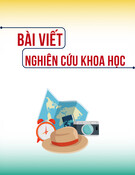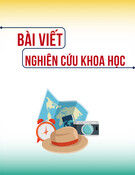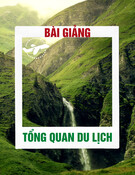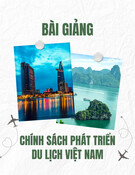
71
Sè §ÆC BIÖT / 2024
THE CURRENT STATE OF INFRASTRUCTURE QUALITY, EQUIPMENT,
AND ENVIRONMENTAL LANDSCAPE AT SPORTS TRAINING
ESTABLISHMENTS IN SPECIALIZED SCHOOLS AND SPORTS
TRAINING CENTERS BASED ON TANGIBLE CULTURAL CRITERIA
Summary
Using criteria related to tangible culture, encompassing cultural institutions and environmental
landscapes within sports training establishments, this study conducts a comprehensive survey and
analysis of the current state of infrastructure, equipment, and environmental landscapes at sports
training establishments in specialized schools and sports training centers in Vietnam. The results
indicate that the quality of infrastructure and landscapes at these establishments meets basic
standards. However, a considerable portion of assessments rated the quality as average, with a
minor segment deeming it substandard or significantly inadequate. While statistical unity exists in
the evaluations provided by various subjects; however, sports practitioners exhibited a higher desire
for enhanced infrastructure, equipment, and environmental conditions at these specialized training
establishments.
Keywords: Cultural environment, quality, tangible culture, environmental landscape.
(1)Assoc. Prof. PhD, Bac Ninh Sports University; Email: ngocbro@gmail.com
Đinh Quang Ngoc(1)
INTRODUCTION
The presence of a sports cultural
environment in physical education and sports is
a pivotal and ongoing responsibility. In addition
to fostering a cultural environment at sports
event venues, it is crucial to implement the
cultural environment in sports training
establishments. Such establishments,
particularly those in sports training centers
(training for high-achievement athletes) and
specialized universities and colleges (under the
management of educational institutions),
possess distinct characteristics that differentiate
them from commercial sports training
establishments. Therefore, evaluating the
current state of infrastructure, equipment, and
environmental landscapes is essential for
providing a comprehensive and accurate
assessment of the sports cultural environment,
based on tangible cultural criteria related to
cultural institutions and landscapes, at sports
training establishments in specialized schools
and sports training centers.
RESEARCH METHODS
The research methods employed in this study
include document analysis and synthesis,
interviews, discussions, expert consultation, and
mathematical statistics.
RESULTS AND DISCUSSION
Based on the survey forms developed in the
previous research phase, we conducted a
nationwide survey of sports training
establishments in specialized schools and sports
training centers to assess the current situation.
Direct surveys were conducted in Hanoi, Ho Chi
Minh City, and Da Nang. Additionally, survey
forms were distributed to other local sports
training establishments through official
channels, and an online survey was sent to
establishments, experts, managers, and staff
involved in specialized schools and sports
training centers across the country.
Specifically, data were collected from 26
establishments and 1,066 individuals, including
leaders, managers, staff, lecturers, coaches,
students, and athletes from national and

p-ISSN 1859-4417 e-ISSN 3030-4822
72
No Criteria Results
Specialized schools sector (n=479) Sports training centers sector (n=587)
Excellent Good Average Poor Very poor Excellent Good Average Poor Very poor
1Compliance with quality and safety stan-
dards for infrastructure and equipment
mi111 212 152 3 1 86 238 238 20 5
%23.17 4.26 31.73 0.63 0.21 14.65 0.55 40.55 3.41 0.85
2Compliance with environmental protec-
tion standards in sports establishments
mi106 228 143 2094 246 231 15 1
%22.13 7.6 29.85 0.42 016.01 41.91 39.35 2.56 0.17
3Cultural aspects of the training establish-
ments' landscape
mi141 197 139 11105 248 229 1 4
%29.44 1.13 29.02 0.21 0.21 17.89 2.25 39.01 0.17 0.68
4
Harmonization of the training facility’s
landscape with nature and environmental
protection
mi150 166 162 10109 222 250 3 3
%31.32 4.66 33.82 0.21 018.57 37.82 42.59 0.51 0.51
Table 1. Current quality of infrastructure, equipment, and environmental landscape at sports training establishments in specialized
schools and sports training centers (n=1066)
provincial sports training centers and
universities, colleges, and specialized
physical education and sports training
institutions. The survey results on the
current quality of infrastructure,
equipment, and environmental landscapes
at sports training facilities in specialized
schools and sports training centers are
presented in two main categories: a
summary of overall survey results (Table
1) and a summary of evaluations based on
the perspectives of related stakeholders
(Table 2).
The findings from Table 1 indicate
that, for sports training establishments in
both schools and training centers, the
majority of respondents rated the quality
of infrastructure, equipment, and
environmental landscape as "Good" or
"Excellent" across all four criteria
(65.98% - 70.57% in specialized school
sector, while 55.2% - 60.14% in sports
training centers sector). Among these, the
specialized school sector received higher
ratings of "Good" and "Excellent"
feedback compared to the sports training
centers sector across all four criteria. The
difference ranges from 9.59% in criterion
4 to 12.23% in criterion 1. This suggests
that, overall, the infrastructure,
equipment, and environmental landscape
at both types of establishments meet
quality standards, with no significant
discrepancies between the two. However,
the survey results also reveal a significant
proportion of respondents rated the
quality of these aspects as "average”
(29.02% - 33.82% in the specialized
school sector, 39.35 - 42.59% in the
sports training centers sector).
Additionally, a small percentage of
respondents rated the quality as "Poor" or
"Very Poor."
The evaluation of the quality of
infrastructure, equipment, and
environmental landscape at sports
training facilities from the perspective of
different stakeholder groups (managers,

73
Sè §ÆC BIÖT / 2024
Table 2. Evaluation results on the current quality of infrastructure, equipment, and environmental landscape at sports training es-
tablishments in training centers and specialized sports schools according to three stakeholder groups (n=1066)
No Criteria Results
Evaluation
c2P
Managers (n=144) Teachers, coaches, instructors,
experts (n=440) Participants (n=482)
Excel-
lent Good Aver-
age Poor Very
poor
Excel-
lent Good Aver-
age Poor Very
poor
Excel-
lent Good Aver-
age
Poo
r
Very
poor
1
Compliance with
quality and safety
standards for
infrastructure and
equipment
mi29 61 50 2273 212 147 5395 177 193 16 1
5.440 0.245
%20.14 42.36 34.72 1.39 1.39 16.59 48.18 33.41 1.14 0.68 19.71 36.72 40.04 3.32 0.21
2
Compliance with
environmental
protection
standards in sports
establishments
mi23 71 49 1073 219 146 11104 184 179 15 0
4.389 0.356
% 15.97 49.31 34.03 0.69 016.59 49.77 33.18 0.23 0.23 21.58 38.17 37.14 3.11 0
3
Cultural aspects
of the training
establishments'
landscape
mi30 66 46 1197 202 137 13119 177 185 01
8.663 0.07
%20.83 45.83 31.94 0.69 0.69 22.05 45.91 31.14 0.23 0.68 24.69 36.72 38.38 0 0.21
4
Harmonization
of the training
facility’s
landscape with
nature and
environmental
protection
mi34 53 56 01 97 165 175 21128 170 181 2 1
5.821 0.213
%23.61 36.81 38.89 00.69 22.05 37.5 39.77 0.45 0.23 26.56 35.27 37.55 0.41 0.21

p-ISSN 1859-4417 e-ISSN 3030-4822
74
teachers, coaches, instructors, experts, and
participants) is presented in Table 2. Although
there were some variations in the distribution of
responses, (χ²) comparison results showed no
statistically significant differences among the
three groups (P > 0.05). This indicates that,
overall, the three groups share a similar view
regarding the quality of infrastructure,
equipment, and environmental landscape at
sports training establishments. Specifically, the
majority of respondents across all groups rated
the quality of these aspects as "Good" or
"Excellent" with 56.43% to 67.95%. Among
them, the group of
teachers/coaches/instructors/experts had the
highest proportion (64.66%), followed by
managers (63.72%) and participants (59.85%).
This suggests that compared to managers and
coaches, participants (students, athletes, etc.)
have higher expectations for the quality of
infrastructure, equipment, and environmental
landscape at sports training establishments in
specialized schools and sports training
centerscenters.
Although the majority of responses are
“Good” and “Excellent”, there is a notable
proportion of respondents (31.14% to 40.04%
across all three groups) rated the quality as
"average." Additionally, 1.87% of participants,
0.97% of teachers/coaches/instructors/experts,
and 1.39% of managers indicated that the
quality of infrastructure, equipment, and the
environmental landscape was "Poor" or "Very
Poor" suggesting that there remains a need for
further improvement and enhancement.
CONCLUSION
The assessment of the current quality of
infrastructure, equipment, and environmental
landscape at sports training establishments in
specialized schools and sports training
centerscenters, based on the criteria related to
tangible cultural factors, reveals that the
majority of survey participants rated the quality
as "Good" or "Excellent". Facilities at
specialized schools get a higher evaluation than
those at training centers. However, there
remains a significant proportion of respondents
who rated the quality as "average," and a
smaller number rated it as "Poor" or "Very Poor"
The survey results across different
stakeholder groups indicate that, while there is
general agreement in evaluations (P > 0.05), the
trainee group rated the quality of infrastructure,
equipment, and environmental landscape lower
than the other two groups. This suggests that
trainees have higher expectations and demands
for the quality of infrastructure, equipment, and
environmental landscape at sports training
establishments in specialized schools and sports
training centerscenters.
REFERENCES
1. Central Committee of the Communist
Party of Vietnam (2011), Resolution No. 08-
NQ/TW dated December 1, 2011, on
strengthening the Party's leadership to create a
strong development in physical training and
sports by 2020.
2. Assoc. Prof. Dr. Hồ Sĩ Quý (2007), On
Cultural Environment and Cultural
Environment in Vietnam. Retrieved from
http://webcache.googleusercontent.com/search?
q=cache:n37BWr2SdiMJ:www.hids.hochiminh.
3. Bui Hoai Son (2022), Scientific Basis for
Building a Cultural Environment, Ministry-level
Research Task, Ministry of Culture, Sports, and
Tourism.
4. 杨文辉 (2001, 论学校体育文化环境的
建设, 韶关学院学报(自然科学版
Yang Wenhui (2001). On the Construction of
the School Sports Cultural Environment.
Journal of Shaoguan University (Natural
Science Edition), China.
Received 14/8/2024, Reviewed 6/11/2024,
Accepted 28/11/2024)


![Đề cương ôn tập Bản đồ du lịch [năm hiện tại]](https://cdn.tailieu.vn/images/document/thumbnail/2025/20250809/dlam2820@gmail.com/135x160/53061754884441.jpg)























